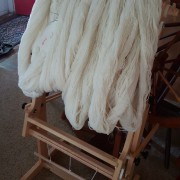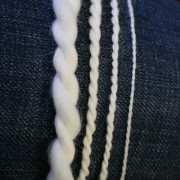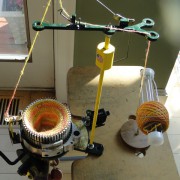The Goldilocks Problem: Staple Length Matters
Staple length—the average length of individual fibers in a fiber preparation—is one of the most important characteristics to consider when preparing and spinning fiber by hand with a worsted technique. Whether you’re spinning Merino or a longwool like Wensleydale, understanding staple length helps you to control your drafting technique and create the yarn you intend.
I consider this the Goldilocks problem of worsted spinning. The goal is to position your hands to allow you to draft “just right.”
Whether you use a forward or backward draw when you spin, your hands draft the fibers out into a narrower strand before or while twist is being added. The distance between your hands creates a drafting zone: if your hands are too close together for the staple length of the fiber, the fibers won’t slide past each other easily. You are essentially holding both ends of the same fiber and I promise the fiber is stronger than you in this tug-of-war match.
If your hands are too far apart, you may lose control of the draft, especially with short fibers. You might find that as you draft, the fiber suddenly comes loose and drifts apart, leaving you holding two separate sections of fiber and a whole lot of frustration.
The ultimate goal is to set your hands at just about the average staple length, so the fibers can move and draft smoothly without pulling apart. Not too wide, not too narrow, but just right.
For short-stapled fibers, like cotton or yak, your hands need to be close together—sometimes only an inch or two apart—to control the drafting and prevent the fibers from slipping apart. One of the reasons we often choose a long draw for these fibers is because of how difficult it can be to maintain such a short draft zone.
Medium-staple fibers, such as Corriedale or Romney, are more forgiving. You can draft them with your hands 4–6 inches apart. Many spinners find their comfort zone in this range.
Long-stapled fibers, like Lincoln or silk, require your hands to be farther apart—sometimes MUCH further apart. If you hold your hands too close, these long fibers won’t draft well; instead, they’ll resist movement or break under the stress.
Matching your hand placement to staple length is essential for an efficient, consistent, and ergonomically sound draft and to avoid unnecessary frustration. If you are ever fighting your fiber while spinning, stop and ask yourself if your hands are too far apart, too close together, or just right!









Leave a Reply
Want to join the discussion?Feel free to contribute!